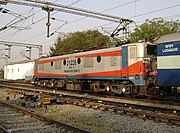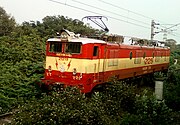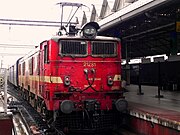This article needs additional citations for verification .(August 2024) |
| WAM-4 | |||||||||||||||||||||||||||||||||||||||||||||||||||||||||||||||
|---|---|---|---|---|---|---|---|---|---|---|---|---|---|---|---|---|---|---|---|---|---|---|---|---|---|---|---|---|---|---|---|---|---|---|---|---|---|---|---|---|---|---|---|---|---|---|---|---|---|---|---|---|---|---|---|---|---|---|---|---|---|---|---|
 Arakkonam based WAM-4 (now scrapped) heading towards Perambur. | |||||||||||||||||||||||||||||||||||||||||||||||||||||||||||||||
| |||||||||||||||||||||||||||||||||||||||||||||||||||||||||||||||
| |||||||||||||||||||||||||||||||||||||||||||||||||||||||||||||||
| |||||||||||||||||||||||||||||||||||||||||||||||||||||||||||||||
| |||||||||||||||||||||||||||||||||||||||||||||||||||||||||||||||
The Indian locomotive class WAM-4 is a class of 25 kV AC electric locomotives that was developed in 1970 by Chittaranjan Locomotive Works for Indian Railways. The model name stands for broad gauge (W), alternating current (A), mixed traffic (M) locomotive, 4th generation (4). They entered service in March 1971. A total of 500 WAM-4 were built at CLW between 1970 and 1983, which made them the most numerous class of mainline electric locomotive till its successor the WAG-5.
Contents
- History
- Origins
- Production
- Rebuilding
- Duties
- Sub-classes
- Livery
- Named locomotives
- Preserved Examples
- Locomotive sheds
- Former sheds
- Technical specifications
- Image Gallery
- WAS-4
- See also
- References
- Bibliography
- External links
The WAM-4 is one of the most successful locomotives of Indian Railways[ peacock prose ] having served both passenger and freight trains for over 52 years. This class provided the basic design for a number of other locomotives like WCAM-1, WAG-5A, WCG-2, and some WAP-1 models. However, with the advent of new 3-phase locomotives like WAP-5 and WAP-7, the WAM-4 locomotives were relegated to hauling smaller passenger trains and most of the units have been scrapped. A few units are in service performing backup and non-essential duties.












